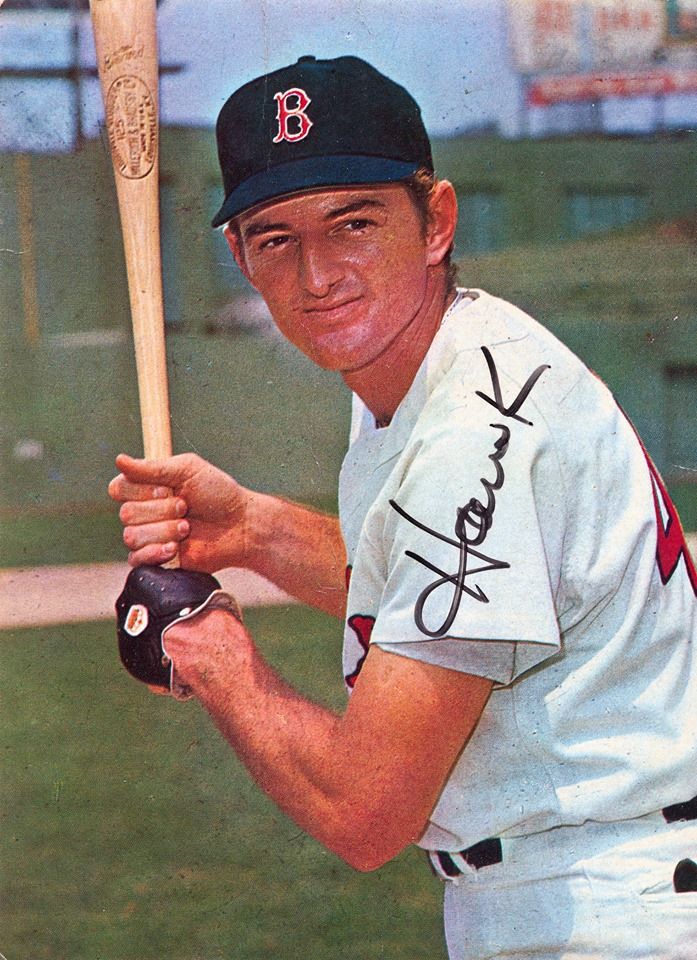Ken “Hawk” Harrelson — A Special Guy
Growing up, baseball was the national pastime.
I spent hours listening to games and watching on television.
There were three teams playing in New York.
The Yankees, the Dodgers, and my beloved Giants.
They all had fantastic announcers. The voice of the perennial world champion Yankees was Mel Allen.
Red Barber was the lead Dodger broadcaster when I started listening and watching, and one of his side-kicks was a youngster in his early 20’s named Vin Scully.
Russ Hodges and Ernie Harwell were the duo that called Giants games and, naturally, I thought they were the best.
Harwell left for Baltimore, and then to Detroit where he became a legend calling Tigers games for 42 years.
Harwell, Allen, and, of course, Scully are in the pantheon of baseball broadcasters.
Baseball announcers had the best jobs in the world, I thought, and never, ever, did I dream that someday I would be doing the same.
But it happened in 1975, when I became the play-by-play telecaster of the Boston Red Sox.
My partner was Ken “Hawk” Harrelson.
Ken “Hawk” Harrelson
You could not have paired a more diverse duo.
Harrelson grew up in Savannah, Georgia and was an outgoing, bigger-than-life batting star who had a relatively short burst of brilliance in the late 60’s.
His career lasted nine years, but the peak came in 1968, a year after he was acquired by the Red Sox.
He came aboard for 23 games in the “Impossible Dream” pennant year of ‘67 after star outfielder Tony Conigliaro was hit in the eye by a pitch, that ended his season, and short-circuited his career.
While Boston failed to repeat a year later, Harrelson had his finest season, capturing the American League RBI crown, driving in 109 runs and earning his only All-Star berth.
The Hawk was a personality on and off the field, often wearing what was known as “Nehru jackets”, extremely popular in India, and a fad for awhile in this country in the 60’s.
The Hawk was colorful, make no mistake.
And he was teamed with a low-key, New York kid whose claim to fame in the sport was relegated to stickball in the streets and alleys of Queens, outside of NYC.
When we first met, Ken looked upon me as someone from a different planet.
But he knew I was the professional broadcaster of the team, and he needed my help, expertise and support, the way I needed someone who knew the game inside-and-out, and would really add color to our broadcasts.
Experience in the booth was where we struggled at the outset.
I had done only a handful of baseball games on HBO, and the Hawk had done none….zero….zilch.
So here we were, at the Red Sox spring training camp in Winter Haven, Florida, watching the club go through its paces each day, all in preparation for the four Grapefruit League telecasts we would do for the new rights-holders, WSBK-TV, a UHF station.
WSBK was owned by Storer Broadcasting and they won the rights by agreeing to air 100-games.
The highest number of Red Sox games televised up until then was about 25.
Remember also, that the year was 1975, which would turn into a magical and memorable season for the Sox.
We were both a bit jittery, (did I say shaking beyond belief), for our first exhibition effort against the Montreal Expos at Chain O’ Lakes Park in Winter Haven.
We were a lot more nervous afterwards because our first telecast out-of-the-gate was a disaster.
I knew it, Hawk knew it, and most of all the station big-wigs knew it.
I thought I handled it as if I never had been on the air before, which might be a bit of an exaggeration.
Let’s just say it wasn’t a smooth performance.
Hawk sounded like the neophyte he was.
It didn’t go over well.
Especially when my partner in praising infielder Tim Foli of the Expos exclaimed, “ I love Foli, he has a big set of b_ _ _ s”.
Our meeting back at the hotel with the station brass lasted well into the night.
The good news is that things got better, way better.
Harrelson and I emerged into a solid team, chronicling the Red Sox march to the Division title and the American League pennant.
I learned so much about baseball from my partner.
He taught me how much the scoreboard dictated what the ensuing strategy would be.
It was fundamental and basic, and until the game evolved into it’s current crazy home run or strikeout scenario, it was the way the game was played.
If you’re at the plate, and ahead on the count, look for a fastball in the strike zone. A good pitch to hit.
If the count is 0-2, a waste pitch might be next. Don’t bite.
If the team was leading, look for chances to steal or hit and run. If behind, don’t take yourself out of an opportunity to get a run or two.
Basic things, that made sense.
The same went for pitchers, and fielders, and how they played the hitters.
Hawk and I were a team for four seasons, but that first one was special for both of us.
He was loyal to the Red Sox, who had obtained his services in 1967, and was forever grateful to owner Tom Yawkey.
When the Red Sox clinched the pennant, sweeping the defending world champion Oakland A’s in three straight games, Ken broke down and wept in the booth, fully understanding what that victory meant to Yawkey, who hadn’t had a winner since that 1967 miracle run.
That game was Harrelson’s last broadcast of the season.
But I was going on to join the NBC team for the World Series against the Cincinnati Reds.
On the overnight team charter flight home to Boston, Hawk ordered me to take out a legal pad to record what he was about to tell me.
Instead of getting much needed sleep prior to arriving in the early morning in Boston to fans celebrating at the airport and in the streets, Ken Harrelson gave me a Masters Degree in the strengths and weaknesses of every member of both our team, and the Reds.
How every played should be pitched to, what the hitters would anticipate, and also try to avoid.
He broke down the teams in big picture fashion.
I had observed the Boston Red Sox all season, and knew all about them.
But what Hawk instilled in me was something only a manager or player would know.
He didn’t have to do this.
I knew that in my World Series role as a play-by-play broadcaster who had covered the Red Sox, I wasn’t there to be the “expert”. NBC had Joe Garagiola and Tony Kubek for that.
But what the knowledge I gleaned from Harrelson did, was give me an assurance and confidence that would serve me well in as significant an assignment as I would ever have.
After four seasons at the Red Sox mike with Harrelson, I departed for CBS. Ken stayed on for a few years and eventually became the chief play-by-play announcer for the Chicago White Sox.
The Hawk retired after last season, wrapping up 33 years with the “ other” Sox.
He was a colorful, and inventive “homer” who was an unabashed White Sox rooter.
He was never objective and his listeners didn’t care.
They loved him.
He was criticized in some quarters for his style, but it never fazed him.
He was a White Sox fan through and through, and he did it his way.
When I was assigned to White Sox games during my baseball years with Fox and TBS, we would visit and talk about the year we started together.
1975. A special year.
Ken “Hawk” Harrelson. A special guy.


